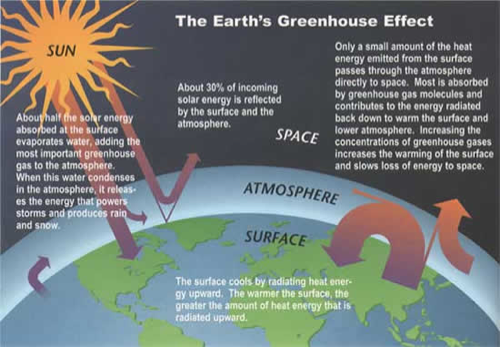Introduction:
What is solar radiation?
Solar radiation is essentially radiation from the sun. When solar radiation meets Earth's atmosphere, part of it is transmitted through the atmosphere, while the other part is reflected back into space. The transmitted radiation travels towards the Earth's surface, and different parts of the spectrum are absorbed by the molecules that make up the Earth's atmosphere. Once the energy that is not absorbed in the atmosphere hits Earth's surface, some of it is absorbed while the rest is reflected back into the atmosphere. About 30% of the energy is reflected by the atmosphere and the surface of the earth. This energy is known as albedo.
What is the Greenhouse Effect?
The Greenhouse Effect is the phenomenon by which Earth's atmosphere traps solar radiation. This is caused by the atmospheric gases (carbon dioxide, water vapor, and methane) which permit the incoming sunlight to pass through but do not allow the heat radiated back from the Earth's surface to pass through. Instead, the atmosphere absorbs the heat. This essentially creates a blanket over the Earth, and is responsible for the heating of the Earth to warmer temperatures that it would not be at otherwise. In fact, without the greenhouse effect, the average surface temperature of the earth would be about 60 degrees fahrenheit cooler.

Why study marine life?
With all of the changes happening to our environment, scientists are looking at how different species are changing. Scientists study the ozone, because its depletion can cause many things, including climate change. In the area of climate change, scientists are focusing more on marine organisms because their movements are linked with their temperature ranges. Marine organisms are more sensitive to climate changes than terrestrial organisms. The smaller the marine organism, the more sensitive they are. Because of this, they tend to stay in their temperature range.
What is the response?
In an experiment done on purple sea urchins, a group of scientists found that higher temperatures caused some developmental stress. The
 urchins that were subjected to higher temperatures were significantly shorter along their animal-vegetal axis. The scientists hypothesized that this decrease in size was because of the increased metabolic demands of development at higher temperatures. The embryos also had less ordered cells in their ectoderms. However, the embryos at the higher temperatures developed through the gastrula stage, which suggests that the embryos were able to buffer their development against temperature stress. These results, however, should not be very surprising. This is because the species has a very large effective population size, high genetic variation, and an extensive gene flow among different populations living in widely varying temperature ranges.
urchins that were subjected to higher temperatures were significantly shorter along their animal-vegetal axis. The scientists hypothesized that this decrease in size was because of the increased metabolic demands of development at higher temperatures. The embryos also had less ordered cells in their ectoderms. However, the embryos at the higher temperatures developed through the gastrula stage, which suggests that the embryos were able to buffer their development against temperature stress. These results, however, should not be very surprising. This is because the species has a very large effective population size, high genetic variation, and an extensive gene flow among different populations living in widely varying temperature ranges.
Comments